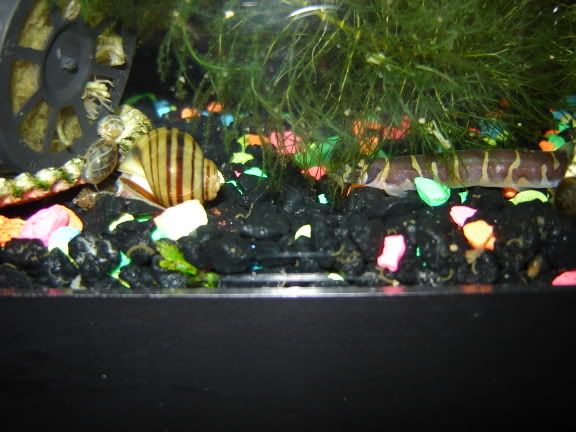The last item worth mentioning is that all "kuhli" loaches aren't necessarily real kuhli loaches. There are a number of very similar species in the genus Acanthophthalmus . The real kuhli loach, Acanthophthalmus kuhlii , is a 3.5 inch fish from Indonesia, Sumatra, Java, Malaya and Thailand. It has 15 to 20 dark bars on its flanks that almost circle the body, but stop at the belly. There are two subspecies (maybe three) that have variations in the length of the bars and narrow bands within the bars.
The first impostor is the Indian thorneyes, Acanthophthalmus cuneovirgatus (Acanthophthalmus means "thorn eye" and refers to the sharp, two pronged spine at the base of each eye), from the Johore province of India. This fish grows to about 2.5 inches and has 10 to 14 short, dark bars that look like triangles over its back and part way down its sides.
Myer's loach (also known as Myer's slimy loach or giant kuhli loach), Acantophthalmus myersi , is a 4-inch species from southeast Thailand. This species is considerably heavier bodied than the normal kuhli loach, and the body has a more slippery or "slimy" texture. It has 10 to 14 long, broad, dark bars that nearly encircle the body.
The dwarf kuhli, Acanthophthalmus robiginosus, is a seldom-seen species from western Java that has about 20 broad dark bars separated by very narrow yellow to yellow-orange bands. The dark bars reach down to just past the mid line of the body. This very attractive species reaches barely 2 inches in length.
Acanthophthalmus semicinctus, the half-banded loach, is a 3-inch species with 12 to 16 dark bars on the flank. There are two or three bars at the head and one or two bars at the tail that circle the body, but the rest of the bars come only to the mid line of the body. This Indonesian species shows more reddish-copper color on the body and seems to prefer warmer waters - from 78 to 85 degrees Fahrenheit.
Another species with a similar color pattern is Shelford's thorneye, Acanthophthalmus shelfordii. Instead of distinct bars, the dark areas are ragged blotches in two horizontal bands. This 3.5 inch species comes from Borneo, Sarawak and the Malay Peninsula.











